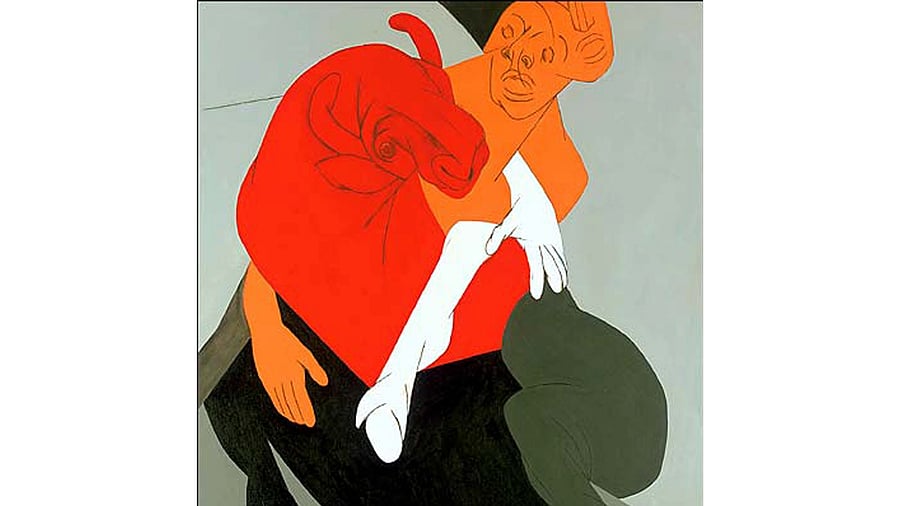
Mahishasura by Tyeb Mehta.
Credit: Wikimedia Commons
Not too long ago in New Delhi, when a prominent art auction house previewed some prized artworks of modern Indian art from its upcoming April 2025 auction, it thrust to the centre a 1956 oil on canvas titled ‘Trussed Bull’, by one of India’s most valuable modern masters, Tyeb Mehta (1925-2009). The presence of Mehta’s work as a highlight of the landmark 25th anniversary sale of the auction house— to be held in Mumbai on April 2, and online on April 2-3—couldn’t have been more appropriate.
To see why ‘Trussed Bull’ is so germane to the upcoming auction, we need to go back to the 1990s, or exactly July 24, 1991, when Dr Manmohan Singh, the then Union Finance Minister, declared in his speech for the Union Budget: “Let the whole world hear it loud and clear. India is now wide awake.”
What he referred to is now popularly known as the economic liberalisation of India. Through tangible measures and intangible yet epochal results, it set the stage for India to metamorphose into a spending economy; it made India conducive for the birth of entities like Saffronart (2000) and for the steady rise in prices of modern Indian art. In September 2005, Tyeb Mehta’s ‘Mahisasura’, a 1997 acrylic on canvas, sold for $1.58 million at a Christie’s auction in New York, becoming the first Indian work of art to cross the million dollar mark. Tyeb Mehta and Saffronart, thus, became synonymous with the story of the birth and rise of the Indian art market; it is purely coincidental that this calendar year also happens to be the birth centenary year of Mehta, who was born in Kapadvanj, Gujarat, on July 26, 1925.
It may be recalled here that just last week, M F Hussain’s painting ‘Gram Yatra’, sold for a record Rs 118.62 crore at a Christie’s auction in New York, making it the most expensive Indian art ever sold.
‘Trussed Bull’ is estimated at Rs 5 crore-Rs 7 crore ($581,400-$813,955), and assumes importance as a rare early work by the master who would go on to evolve that visual language into a signature that is one of the most valued in Indian modern art. The Indian art market itself has come a long way since 2005. Today, the top three works of Indian art by value (besides the M F Hussain work) are: ‘The Story Teller’ by Amrita Sher-Gill, sold for Rs 61.8 crore at a Saffronart auction in September 2023; ‘Gestation’ by S H Raza, sold for Rs 51.75 crore at a Pundole’s auction in September 2023; ‘Untitled’ (1980) by V S Gaitonde, sold for Rs 47.5 crore at a Saffronart auction in March 2023.
The Indian art market has seen phenomenal changes in these 25 years, which can be plotted on a graph with a jagged line that rose sharply till 2008, when it experienced a serious course correction as a consequence of the global economic meltdown in 2008.
Says Minal Vazirani, president and co-founder of Saffronart, “When the financial crisis hit in September 2008, the global modern and contemporary Indian art auction market dropped drastically to about one-third its value in 2009 from the high of the previous year. It was a challenging time for the global economy, and the art market was no exception. After the 2008 financial crisis and then the terror attacks in Mumbai at the end of the same year, the art market was indeed impacted drastically.”
After the 2008 economic downturn, the art market corrected itself, cooling off the severely hot prices of previous years and cutting out speculation, all of which brought an increased focus on top-quality works of art. Most contemporary works (by younger artists) that were selling at inflated prices fell off the radar. A New Delhi gallerist, on condition of anonymity, says, “The focus on modern masters post the economic crisis was a reaffirmation of the top-quality works of Indian art, which had a history behind them and had undergone an evolutionary process after years of hard work. Contemporary works — not all but those without much depth and purely benefitting with the market’s bull run — collapsed and were edged out.”
Since then, the market has risen slowly and gradually and also struck roots that are increasingly going deeper. In this context, it is vital to note that the top three works of Indian art by market value mentioned earlier have all been sold in sales in India by auction houses that primarily focus on Indian art, unlike the earlier record prices that would invariably be set at auctions abroad. Even during the pandemic, the art market continued to report robust sales.
The 25th-anniversary sale at Saffronart, therefore, is seminal as it is veritably a celebration of the birth of the Indian art market itself, as we understand it today. Apart from ‘Trussed Bull’, some other highlights include a 1932 oil on canvas by Amrita Sher-Gil, estimated at Rs 12 crore-Rs 15 crore; oil on canvas by the earliest American Orientalist to come to India, Edwin Lord Weeks, titled ‘Lake at Oodeypore, India’, circa 1893, estimated at Rs 12 crore-15 Rs crore; S H Raza’s acrylic on canvas, and ‘Bindu Visarg’, 2010, estimated at Rs 2 crore-Rs 3 crore.
The writer is a New Delhi-based journalist, art critic and curator.